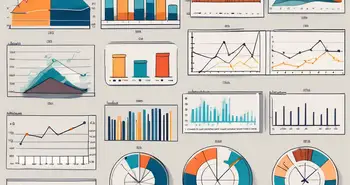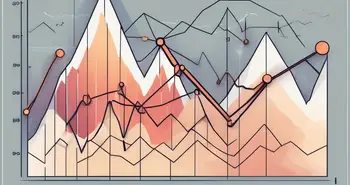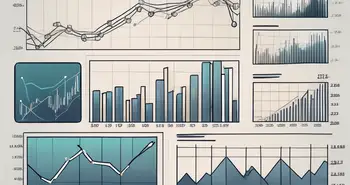The Importance of Leading Indicators in Predicting Future Trends

Leading indicators play a crucial role in forecasting and predicting future trends. By analyzing these indicators, businesses and individuals can gain valuable insights into the direction of the market and make informed decisions to stay ahead of the curve. In this article, I will explain the significance of leading indicators, how they work, their benefits, as well as their limitations and the future of this predictive analysis tool.
Understanding Leading Indicators
Leading indicators are often used in the field of economics and financial markets to gauge the future trajectory of various factors. They are statistical measures that change before the economy or market as a whole does. Unlike lagging indicators, which follow trends that have already occurred, leading indicators help anticipate shifts in the economy, business cycles, and market trends.
Leading indicators play a crucial role in providing valuable insights into the potential direction of the market and economy. By analyzing these indicators, investors, policymakers, and analysts can make informed decisions and prepare for upcoming changes in various sectors. These indicators serve as early warning signals, allowing stakeholders to adjust their strategies and positions accordingly to mitigate risks and capitalize on opportunities.
Definition of Leading Indicators
Leading indicators are metrics that provide an early warning sign of potential changes in the market or economy. They are used to identify trends, direction, volatility, and momentum. Examples of leading indicators include consumer confidence indexes, stock market indices, new housing starts, and jobless claims data. By analyzing these indicators, analysts can develop insights into the future trajectory of the economy.
Consumer confidence indexes, for instance, reflect the sentiment and spending behavior of consumers, offering valuable clues about future economic activity. Similarly, new housing starts indicate the health of the real estate market and overall consumer demand. Jobless claims data can signal shifts in employment trends, providing a glimpse into the labor market's strength or weakness.
Different Types of Leading Indicators
There are various types of leading indicators, each providing unique insights into different aspects of the market and economy. Some common types include financial indicators, such as the stock market index and interest rates, and economic indicators, such as housing starts and consumer sentiment indexes. Other leading indicators include technological advancements, demographic shifts, and geopolitical events.
Technological advancements, for example, can act as leading indicators by signaling changes in consumer preferences, market disruptions, and industry innovations. Demographic shifts, such as aging populations or changing workforce dynamics, can have profound implications for future economic trends. Geopolitical events, like trade agreements or political unrest, can also serve as leading indicators by influencing market sentiment and global economic stability.
The Role of Leading Indicators in Forecasting
Leading indicators are instrumental in forecasting future trends and identifying potential turning points in the market or economy. By analyzing these indicators, businesses and individuals can assess the overall direction and momentum, giving them a competitive edge in decision-making.
Understanding leading indicators is crucial for strategic planning and risk management. These indicators serve as early warning signals, alerting stakeholders to potential changes in economic conditions before they fully materialize. By incorporating leading indicators into forecasting models, organizations can make informed decisions and adapt their strategies proactively.
How Leading Indicators Work
Leading indicators involve a combination of quantitative and qualitative data analysis. By examining historical patterns, trends, and relationships, analysts can infer potential future outcomes. These indicators help to assess the direction and strength of economic activity and the likelihood of future trends.
Quantitative leading indicators include metrics such as stock market performance, consumer confidence indexes, and housing starts. On the other hand, qualitative leading indicators encompass factors like business sentiment surveys, purchasing manager indices, and jobless claims data. By analyzing both types of indicators, a more comprehensive view of the economic landscape can be obtained.
The Relationship Between Leading Indicators and Future Trends
Leading indicators provide insights into future trends by indicating when a market or economy is likely to shift. They act as a compass, guiding businesses and individuals towards potential opportunities or risks. By monitoring these indicators, proactive measures can be taken to capitalize on emerging trends or mitigate potential downturns.
Moreover, leading indicators play a vital role in scenario planning and stress testing. By simulating various economic scenarios based on leading indicator trends, organizations can evaluate the resilience of their strategies and identify areas for improvement. This proactive approach enables businesses to stay ahead of the curve and navigate through uncertain times with greater agility.
Benefits of Using Leading Indicators
Using leading indicators offers several key advantages for businesses and individuals looking to stay ahead of the competition and make informed decisions.
Enhancing Business Strategy with Leading Indicators
Leading indicators empower businesses to strategically plan for the future. By identifying emerging trends, companies can adapt their products, services, and business models to align with the changing market dynamics. This proactive approach helps businesses maintain a competitive edge and capitalize on emerging opportunities.
Risk Management and Leading Indicators
Leading indicators also play a crucial role in risk management. By monitoring these indicators, businesses can identify potential risks and take appropriate precautions to mitigate them. For example, leading indicators can help predict market downturns or disruptions, allowing businesses to adjust their strategies, diversify their portfolios, or take defensive measures to mitigate potential losses.
Criticisms and Limitations of Leading Indicators
While leading indicators provide valuable insights, it is essential to recognize their limitations and potential pitfalls.
Potential Pitfalls in Interpreting Leading Indicators
One potential pitfall is the overreliance on leading indicators without considering other contextual factors. Leading indicators provide insight, but they should be used alongside other data points and expert analysis to form a comprehensive view. Additionally, leading indicators may not always accurately predict future outcomes, as economic circumstances can change rapidly in response to external events or shifts in consumer behavior.
Overcoming Challenges with Leading Indicators
To overcome these challenges, it is crucial to combine leading indicators with lagging indicators and qualitative analysis to develop a holistic understanding of the market. Furthermore, regularly reviewing and updating the indicators used, along with adapting to new technologies and data sources, can enhance the accuracy and effectiveness of predictions.
The Future of Leading Indicators
The field of leading indicators is constantly evolving, shaped by advancements in technology and changing market dynamics.
Technological Advancements and Leading Indicators
Technological advancements, such as big data analytics, artificial intelligence, and machine learning algorithms, have revolutionized the capabilities of leading indicators. These advancements allow for more accurate and real-time analysis of vast amounts of data, enabling businesses and individuals to make more precise predictions and proactive decisions.
The Evolving Role of Leading Indicators in Predictive Analysis
As the world becomes more interconnected, leading indicators will continue to play a crucial role in predictive analysis. By analyzing various economic, financial, and social signals, businesses and individuals can anticipate upcoming trends, adapt their strategies, and seize opportunities before they fully materialize.
FAQs
What are leading indicators?
Leading indicators are statistical measures that change before the economy or market as a whole does. They provide insights into the future trajectory of various factors and help businesses and individuals make informed decisions.
How do leading indicators work?
Leading indicators work by analyzing historical patterns and relationships to infer potential future outcomes. They act as early warning signs of potential changes in the market or economy.
What are some examples of leading indicators?
Examples of leading indicators include consumer confidence indexes, stock market indices, new housing starts, and jobless claims data. These indicators help forecast trends and provide valuable insights into the direction of the market.
What are the benefits of using leading indicators?
Using leading indicators enhances business strategy, aids in risk management, and allows businesses to capitalize on emerging trends and opportunities. They provide a competitive edge and help to mitigate potential downturns.
What are the limitations of leading indicators?
Leading indicators should not be solely relied upon for decision-making, as they have limitations. Economic circumstances can change rapidly, and external events can impact outcomes. However, by combining leading indicators with lagging indicators and qualitative analysis, their effectiveness and accuracy can be enhanced.
What is the future of leading indicators?
The future of leading indicators is promising, with technological advancements revolutionizing their capabilities. Technologies such as big data analytics and artificial intelligence will enable more precise predictions, empowering businesses and individuals to make proactive decisions.
In conclusion, leading indicators are invaluable tools in predicting future trends. By analyzing these indicators, businesses and individuals can anticipate shifts in the market and economy, enhance their strategies, and stay ahead of the competition. Despite their limitations, leading indicators, when used in conjunction with other data and analysis, provide a competitive advantage and help optimize decision-making. As technology continues to advance, the future of leading indicators looks promising, enabling businesses and individuals to make even more precise predictions and proactive choices. So, embrace the power of leading indicators and stay ahead of the curve.
Ready to harness the power of leading indicators and stay ahead in the ever-evolving market? Look no further than Morpher, the revolutionary trading platform that's changing the game with blockchain technology. With Morpher, you can trade a variety of asset classes with zero fees, infinite liquidity, and the option for fractional investing. Whether you're looking to profit from market downturns through short selling or amplify your trades with up to 10x leverage, Morpher offers a unique and flexible trading experience tailored to your needs. Take control of your investments with the safety of the Morpher Wallet and be part of a global community that's democratizing trading. Sign Up and Get Your Free Sign Up Bonus today to transform the way you invest and capitalize on future trends with precision and confidence.

Disclaimer: All investments involve risk, and the past performance of a security, industry, sector, market, financial product, trading strategy, or individual’s trading does not guarantee future results or returns. Investors are fully responsible for any investment decisions they make. Such decisions should be based solely on an evaluation of their financial circumstances, investment objectives, risk tolerance, and liquidity needs. This post does not constitute investment advice.

Painless trading for everyone
Hundreds of markets all in one place - Apple, Bitcoin, Gold, Watches, NFTs, Sneakers and so much more.

Painless trading for everyone
Hundreds of markets all in one place - Apple, Bitcoin, Gold, Watches, NFTs, Sneakers and so much more.








